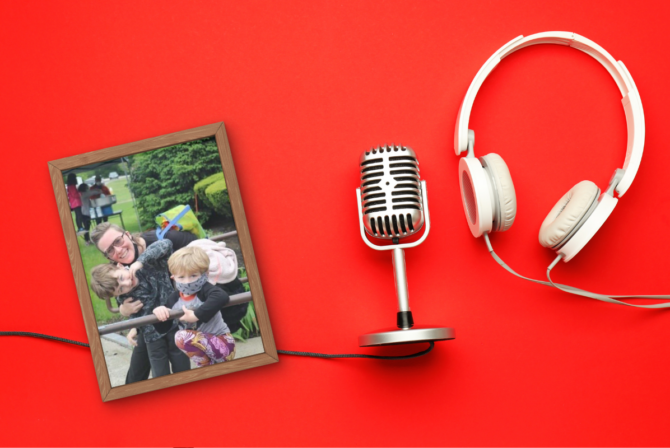I peeled the apples slowly, methodically. That’s why my mom introduced the lemon juice. We needed something to keep the first few from browning as I slowly took bits of skin off the last of the bunch and pushed each through the corer and cutter. It drove me crazy if, after coring, there was still a bit of red or green on the usable fruit, and I needed to trim those pieces as well.
When all apples were trimmed into wedges and transferred to my mom’s oval glass dish, I’d squeeze on more lemon juice before sprinkling in a good amount of cinnamon, a pinch of cloves, and an even tinier bit of nutmeg. I’d shower the whole lot with brown sugar, then pour in a glug of apple cider before using my hands to mix the whole thing together. I’d taste and adjust, then, a la 1987, top it with the glass lid and cook it for 10 minutes in the microwave. Rosh Hashanah dinner was in a couple hours and I had contributed. I was 8 years old.
That was the beginning of “Brooke’s Apples.” Every holiday, they were included on the menu, written between the chicken and the latkes or the matzah balls and the kugel. Some Rosh Hashanahs they were sweeter because I went a little crazy with the sugar; some Passovers they were tangy because I poured in orange juice instead of apple; and sometimes, well, they were way too intensely spiced because I was young, never measured, and loved to tinker.
No matter what they tasted like, my grandmother always asked for the dish to be passed her way, always telling me that they were so good. Even at 8, serving my first apple experiment with pride, I knew she would have been raving if they were the best thing she ever tasted, or if the apples were charred and laced with whole cinnamon sticks. That was my grandmother—such a giant fan of ours that it was easy to never know if we were on the brink of failure or success.
I couldn’t tell you when they stopped showing up on the table. My mom moved to a new house and I went to college, started working, and ultimately attended culinary school. If there were latkes on the table, there was always applesauce, but it was no longer mine. Somewhere in there I became the person who always needed to try something new: making matzah balls with ginger and chives; throwing scallions and sesame oil into my challah; making rugelach with red pepper jelly. The next year, all of it would be different, again.
But now, I’m about to host my first Rosh Hashanah since having our daughters, three years ago and five months ago, and I’ve been thinking so much about tradition. What are they going to remember from their childhoods? Which foods will they crave and tell their friends about? What will they remember stirring together in the kitchen? Will they, like us, be the kids who never rushed away from the table during holiday dinners because they were having so much fun? I hope so.
Part of my responsibility, I’m understanding more and more, is to give them these traditions, both big and small. Hopefully they’ll love experimenting with different flavors, but I want them to have classic dishes they remember and talk about, too. I want them to have recipes that it wouldn’t be a holiday without (my poor mother has been trying to break away from her simple crouton and onion Thanksgiving stuffing for years, to no avail).
But, if I hope to start something for them at the beginning of this New Year, I better like it, too. So, I’m swapping out the cinnamon, brown sugar, and nutmeg for browned butter, honey, and thyme. I’m baking them in the oven the day before, because I’m producing an entire dinner, not just one dish. And, I’ll be thinking of my grandmother, who our younger daughter is named for, who would have been horrified that there was butter in an otherwise perfectly healthy side of baked apples, but would have eaten them anyway, and told me that they were so, so good.
Baked Apples with Brown Butter, Honey and Thyme
Choose a variety of apples—this is best when made with a mixture of tart and sweet, and with wedges that both break down and hold their shape in the oven. I used a combination of Fuji, Granny Smith, and Braeburn. To measure the honey, dip your measuring spoon into the cooled brown butter, which will help grease the spoon, allowing the honey to slide right off.
¼ cup unsalted butter, cut into cubes
3-4 tablespoons honey, depending upon the tartness of your apples
3 tablespoons water, apple juice or apple cider
Pinch kosher salt
3 generous pounds assorted apples (about 9)
½ lemon, juiced
3 sprigs fresh thyme
Make sure your rack is in the center of the oven. Heat oven to 350°F.
In small, light bottomed skillet over medium-low heat, melt butter. Let cook, undisturbed. After 4-5 minutes, the butter will foam and solids will start to be visible. Swirl skillet occasionally, watching for the solids to turn brown and everything to smell toasty. Swirl pan, watching carefully for all of the butter to turn golden. Immediately transfer browned butter to a small bowl to stop the cooking process. Set aside.
Meanwhile, wash and peel apples. Slice fruit away from the core and cut into ⅓-inch wedges. Discard cores.
Places apples in Dutch oven, casserole dish with lid or other 2-quart roasting pan. Immediately toss with lemon juice. Place thyme sprigs on top of apples.
Stir honey, salt and water into browned butter. Pour over apples and toss to combine.
Cover with lid or aluminum foil. Bake 40 minutes, or until the mixture is bubbly, the softer apples are breaking down and the firmer apples are tender, stirring once. Remove and discard thyme sprigs. Apples are best served warm or at room temperature, but straight from the fridge works, too.
Read More:
How to Choose a Hebrew Name for Your Baby
Wondering when is Rosh Hashanah 2016? Find out here.
When is Yom Kippur 2016? Click here to find out!







